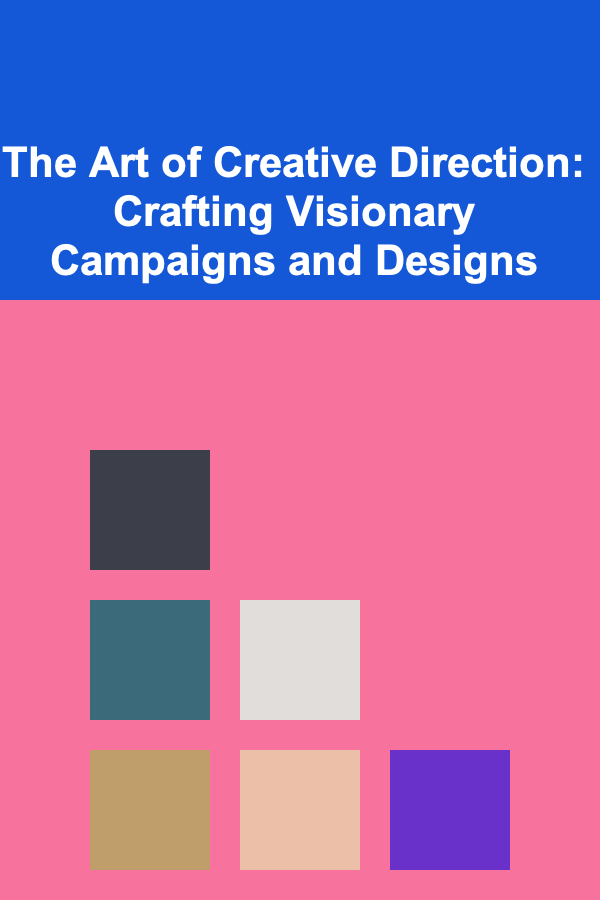
How to Provide Advertising Design and Production Services: A Comprehensive Guide
ebook include PDF & Audio bundle (Micro Guide)
$12.99$7.99
Limited Time Offer! Order within the next:

In today's competitive market, businesses of all sizes rely heavily on advertising to reach their target audiences and drive growth. As an advertising design and production service provider, you have the opportunity to create impactful campaigns that not only meet the client's needs but also push creative boundaries. Whether you're a freelancer, part of a design agency, or managing a dedicated team, offering advertising design and production services involves a multi-faceted approach that combines creativity, technical skills, and strategic thinking.
This actionable guide will walk you through the essential steps to successfully provide advertising design and production services. From understanding client needs to final delivery, here's how you can ensure your services stand out and drive results for your clients.
Understand Your Client's Business and Objectives
The foundation of any successful advertising campaign is a deep understanding of the client's business, industry, target audience, and marketing goals. To provide effective advertising design and production services, you need to build a strong relationship with the client and have a clear understanding of their needs. Here's how to go about it:
a) Initial Consultation
Start with an in-depth consultation to understand the client's brand, values, target demographic, and long-term objectives. The more you know about the client's business, the better you can align your designs with their vision.
- Ask key questions about the business:
- What are your primary marketing goals? (e.g., brand awareness, lead generation, product promotion)
- Who is your target audience?
- What are your current advertising channels (e.g., social media, print, TV)?
- Do you have any brand guidelines or past campaigns that we should consider?
b) Brand Assessment
Study the client's current branding elements, such as their logo, color scheme, typography, and tone of voice. Ensure consistency across all advertising materials to reinforce the brand's identity and create a cohesive message.
c) Budget and Timeline
Establish clear parameters for the project. Discuss the budget to understand the resources available for the campaign and agree on a realistic timeline for delivery.
Develop a Creative Brief
A creative brief is a critical document that helps align your vision with your client's expectations. It serves as a roadmap for the design and production process, ensuring that everyone is on the same page.
a) Campaign Goals
Clearly outline the objectives of the campaign, whether it's increasing website traffic, boosting product sales, or driving foot traffic to a physical store.
b) Target Audience
Define the demographic, psychographic, and behavioral characteristics of the audience you're designing for. This helps you create messages and visuals that resonate with the target market.
c) Key Message
Identify the key message that needs to be conveyed in the ad. This could be a call to action, a product feature, or a brand value. The message should be clear, concise, and compelling.
d) Tone and Style
Establish the tone of the campaign (e.g., professional, humorous, emotional, etc.) and outline any stylistic preferences, including color palettes, typography, and visual elements.
e) Media Platforms
Determine which platforms the advertisements will be displayed on, such as digital (social media, websites), traditional media (TV, print), or outdoor (billboards). Each platform may require different design specifications.
f) Deliverables
Define the deliverables, including the number of assets, format (e.g., JPG, PNG, video, HTML5), and dimensions for each platform. Ensure that you understand any technical requirements related to each media type.
Brainstorm and Concept Development
The creative process starts with brainstorming. You'll need to generate a variety of ideas and concepts based on the creative brief. This stage is where you explore different possibilities and push the boundaries of what the client might expect.
a) Sketching and Ideation
Before jumping into digital design, sketch out rough concepts to visualize potential layouts, compositions, and key visual elements. This can help you explore different options quickly.
b) Mood Boards
Create mood boards that include references for colors, typography, imagery, and the overall aesthetic. Mood boards are a great way to share your vision with the client and ensure alignment before diving deeper into the design.
c) Concept Presentation
Develop multiple concepts based on the ideas you've brainstormed and present them to the client. These concepts should include preliminary visuals and a brief explanation of how they align with the campaign's goals and messaging.
- Pros and Cons: Explain the strengths and weaknesses of each concept. This helps the client understand your design thinking and make a more informed decision.
d) Client Feedback
Once the client reviews the concepts, gather detailed feedback and revise the design accordingly. This iterative process may go through several rounds of refinement before the final direction is chosen.
Design and Production
Once you've finalized the concept with the client, it's time to move into the design and production phase. This is where the bulk of the creative work happens, and attention to detail is crucial.
a) Visual Design
Create the visual assets based on the approved concept. This may include:
- Graphic Design: Logos, illustrations, icons, and imagery.
- Typography: Choosing fonts that are consistent with the brand and legible across different mediums.
- Layout and Composition: Arrange elements to guide the viewer's eye and make the message clear.
b) Video and Motion Design
If your campaign includes video or animation, work with motion graphics to create dynamic content that will capture attention. Ensure that video ads are optimized for both desktop and mobile screens.
- Storyboarding: For video production, create a storyboard to map out the sequence of shots, transitions, and key moments in the ad.
- Voiceovers and Sound Design: If needed, add voiceovers and background music that complement the visuals.
c) Testing and Optimization
Test the designs on various platforms to ensure that they look great across different screen sizes, orientations, and devices. For video content, verify that it plays smoothly across browsers and media players.
- A/B Testing: For digital ads, you can A/B test different versions of your creative to see which performs better. This helps optimize the campaign's effectiveness before going live.
d) Final Adjustments
Once the designs have been tested and approved, make any final adjustments to ensure they are polished and ready for production.
Deliver the Final Assets
After final approval from the client, package and deliver all the assets as per the agreed specifications. This includes all the necessary file formats, dimensions, and resolution for each media platform.
- Digital Assets: Provide files in appropriate formats (e.g., JPG, PNG, MP4, GIF, etc.) for use on social media, websites, email campaigns, and display ads.
- Print Assets: For print advertisements, ensure that you provide high-resolution files and follow the specifications for the type of print material (e.g., posters, flyers, brochures).
- Media Placement: If applicable, assist the client with placing the ads across various media channels. For digital ads, you can provide the creatives to the marketing team or agency responsible for ad placement.
Monitor Campaign Performance
After the campaign has been launched, it's important to monitor its performance and ensure that it meets the client's goals. This stage involves analyzing how well the advertising is performing and making any necessary adjustments.
a) Analytics and Reporting
Use analytics tools to track key metrics such as click-through rates (CTR), conversion rates, impressions, and engagement levels. Provide your clients with regular reports on campaign performance.
b) Optimization
If the campaign is not performing as expected, work with the client to optimize it. This could involve tweaking the design, modifying the copy, or adjusting the targeting strategy to improve results.
Build Long-Term Relationships
Advertising design and production are not one-off services. Building long-term relationships with clients is key to securing repeat business and creating a steady stream of work.
a) Follow-Up
After the campaign ends, follow up with the client to assess the campaign's effectiveness and gather feedback. Ask about their experience working with you and what can be improved in future campaigns.
b) Client Retention
Offer ongoing services, such as social media management, content creation, or brand strategy, to continue adding value to your client's marketing efforts. The more services you offer, the more likely clients are to return for future campaigns.
c) Referrals
Encourage satisfied clients to refer your services to others. Word-of-mouth recommendations are one of the best ways to grow your advertising design and production business.
Conclusion
Providing advertising design and production services requires a blend of creativity, technical skills, and strategic thinking. From understanding client needs to delivering high-quality designs and monitoring campaign performance, every step in the process is critical to ensuring success. By building strong client relationships, maintaining clear communication, and continuously optimizing your processes, you can offer valuable advertising solutions that help businesses stand out in a crowded market.

Creative Ways to Start Saving on Children's Education Expenses Early
Read More
How to Implement Kitchen Storage Ideas That Save Space and Time
Read More
How to Start Investing in Cryptocurrencies Safely
Read More
The Art of Creative Direction: Crafting Visionary Campaigns and Designs
Read More
How To Get Started with Esports Journalism
Read More
How to Use Balance Transfers to Reduce Credit Card Debt
Read MoreOther Products

Creative Ways to Start Saving on Children's Education Expenses Early
Read More
How to Implement Kitchen Storage Ideas That Save Space and Time
Read More
How to Start Investing in Cryptocurrencies Safely
Read More
The Art of Creative Direction: Crafting Visionary Campaigns and Designs
Read More
How To Get Started with Esports Journalism
Read More